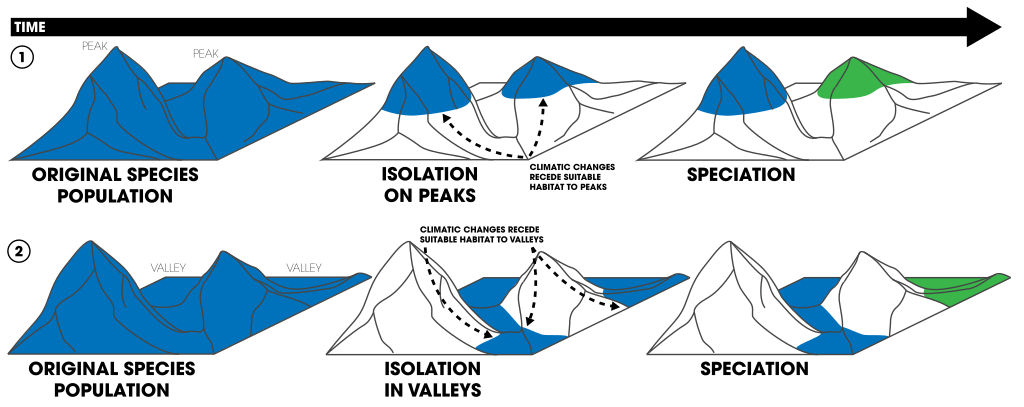Speciation is a core concept in evolutionary biology and a crucial topic for AP® Biology students. To define speciation, it helps explain how new species emerge and why biodiversity is so vast. Understanding speciation makes it easier to see the connections between environments, genetics, and adaptations. This guide provides a friendly introduction to the subject while remaining thorough and organized.
What We Review
Introduction
Speciation refers to the process by which one population splits into two or more distinct species over time. This phenomenon lies at the heart of evolutionary biology because it helps us understand how life on Earth becomes more diverse. For AP® Biology students, studying speciation offers insights into broader themes, such as natural selection and genetic variation.
Next, we will discuss the definition of speciation and explore the mechanisms that can lead to the formation of a new species. Concrete examples, like the famous Galápagos finches, will clarify each concept step by step.
What Is Speciation?
Speciation is the process in which a single ancestral species branches out into multiple new species. These new species differ enough that they can no longer interbreed successfully with the original population. Consequently, they follow separate evolutionary paths. A species is often defined as a group of organisms that can reproduce and form fertile offspring. Speciation matters because it explains the diversity of life forms we see on Earth today.
Example: The Emergence of a Flower Variety
Imagine a population of flowering plants. Over time, some plants might develop a different scent or bloom schedule. Eventually, these changes keep them from reproducing with the original group. As the changes accumulate, they will become separate species.
Step-by-Step Explanation
- Original flower population experiences mutations, like different scents.
- Flowers with new scents attract different pollinators.
- Over many generations, these mutated flowers breed mainly among themselves.
- Genetic differences become significant, leading to a new species that can no longer cross-pollinate with the old one.
How Does Speciation Occur?
Speciation usually requires reproductive isolation. In other words, something prevents gene flow between groups in a population. This can happen because of physical barriers (like mountains) or behavioral changes (like distinct mating calls).
A Quick Hardy-Weinberg Refresher
Often, we examine population genetics to see how allele frequencies might change. The Hardy-Weinberg principle says that in an ideal population (no mutation, no gene flow, random mating, no natural selection, very large population), allele frequencies remain steady.
p + q = 1Here, p is the frequency of one allele, and q is the frequency of the other allele.
If a barrier separates part of this population, the smaller group’s allele frequencies may shift over time. Eventually, these changes can contribute to speciation.
Step-by-Step Example of Allele Frequencies
- Suppose a population has two alleles, A and a. Initially, p = 0.7 and q = 0.3.
- A geographical barrier then divides the population. The new group is smaller.
- Over time, mutation or selection in the isolated population changes p and q.
- After many generations, the group’s genetics differ so much that they cannot interbreed with the original group.
- This isolation can lead to the emergence of a new species.
Types of Speciation
Speciation comes in several forms, depending on whether populations are physically separated or remain together.
Allopatric Speciation (Geographic Speciation)
Allopatric speciation occurs when a physical barrier (like a river or mountain range) splits a population, preventing different groups from mating with each other. Over time, genetic differences accumulate.
Causes:
- Rising mountain ranges
- Shifting rivers or changing water levels
- Continental drift
Result:
- Distinct populations that evolve into new species

Example: Galápagos Finches
The Galápagos finches are a classic case of allopatric speciation. Different islands in the Galápagos region provided unique environments. Each isolated group developed distinct beak shapes and sizes to exploit local food sources.
Step-by-Step Explanation
- An ancestral finch population arrived on one island.
- Some birds flew to a neighboring island, where they were separated from the first group.
- Over generations, the new island’s conditions favored certain beak shapes, leading to natural selection of those traits.
- The new island finches eventually became genetically distinct from the original group.
- These differences grew so large that the two groups did not interbreed, forming separate species.
Sympatric Speciation
Sympatric speciation happens in populations that share the same geographic space. Even though there is no physical barrier, reproductive isolation develops due to different factors like changes in mating rituals or sudden genetic shifts (e.g., polyploidy in plants).
Example: Cichlid Fishes in African Lakes
The cichlid fishes in African lakes illustrate sympatric speciation. They live in the same lake but occupy different feeding zones or show preferences for distinct mating colors. Over time, these behavioral and ecological differences keep them from interbreeding.
Step-by-Step Explanation
- A single cichlid population inhabits a large lake.
- Some fish develop a preference for a certain food source, while others adapt to a different one.
- Mating behaviors diverge, with color patterns or breeding dances recognizing certain partners only.
- These preferences reduce gene flow between the two groups.
- Eventually, each group’s genetic changes are large enough to create separate species.
Reproductive Isolation: Key to Speciation
Reproductive isolation ensures that populations no longer exchange genes. It can happen before fertilization (prezygotic) or after fertilization (postzygotic).
Prezygotic Mechanisms
Prezygotic barriers prevent mating or fertilization. Examples include:
- Temporal Isolation: Mating at different times or seasons.
- Behavioral Isolation: Unique courtship rituals.
- Mechanical Isolation: Incompatible reproductive structures.
Postzygotic Mechanisms
Postzygotic barriers come into play after fertilization. Examples include:
- Reduced Hybrid Viability: Hybrid offspring do not survive well.
- Reduced Hybrid Fertility: Hybrid offspring are infertile (like mules).
- Hybrid Breakdown: Hybrids survive, but future generations become weaker.
Example of Prezygotic Isolation
Two frog species in the same pond may have mating calls at different times of the evening. So, they never interbreed even though they share a habitat.
Step-by-Step Explanation
- Both frog species live in the same pond.
- Frog A calls at dusk, while Frog B calls at midnight.
- The timing difference means they never share mating periods.
- No gene flow occurs between their gene pools.
- Over several generations, they remain distinct species.
Patterns of Speciation: Punctuated Equilibrium vs. Gradualism
Once isolation begins, new species can appear at different rates.
- Gradualism: Proposes that species evolve slowly and steadily over time, like a continuous slope.
- Punctuated Equilibrium: Suggests that species stay stable for long periods and then undergo rapid changes during short events (often triggered by sudden environmental shifts).
Example: The Fossil Record
Fossil records sometimes show stable forms for millions of years (stasis). Then, a layer of fossils reveals a sudden appearance of new forms (punctuation). This pattern supports punctuated equilibrium. However, other fossil lines show slow, continuous transitions, aligning with gradualism.
Step-by-Step Explanation
- Researchers study a fossil series in rock layers.
- Early layers reveal a species with little change for thousands of years.
- Suddenly, a new fossil form appears in the layers above.
- This abrupt shift indicates a rapid evolutionary change, supporting punctuated equilibrium.
- In other examples, fossils show a smoother, slower transition from one form to another, illustrating gradualism.
Divergent Evolution and Adaptive Radiation
Divergent Evolution
This evolution happens when related species evolve different traits due to new environments or selective pressures. These species share a common ancestor but become increasingly distinct.
Adaptive Radiation
Adaptive radiation is a special form of divergent evolution where an ancestral species rapidly diverges into many species. This often occurs in environments with abundant, varied resources and minimal competition from other species.
Example: Darwin’s Finches
On the Galápagos Islands, Darwin’s finches evolved multiple beak shapes. Each shape suited a different diet (seeds, insects, etc.). With few competitors, the finches rapidly filled all available niches. This burst of new species is a classic case of adaptive radiation.
Conditions Promoting Speciation
Several factors promote speciation:
- Geographic Isolation: Physical barriers like mountains or oceans.
- Ecological Opportunities: Untapped resources or unoccupied niches.
- Rapid Environmental Change: Sudden shifts can create strong selective pressures.
- Genetic Drift in Small Populations: Random changes in allele frequencies can accumulate.
Example: Island Isolation
Islands often accelerate speciation. When a small group of organisms colonizes an isolated island, the reduced gene pool allows random changes to become fixed faster. Environmental differences from the mainland further drive adaptation.
Step-by-Step Explanation
- A few lizards float on driftwood to a remote island.
- The new environment has different predators and food sources.
- Over generations, unique traits arise and spread in the small population.
- The island population diverges genetically from its mainland relatives.
- Ultimately, the island lizards become a new species.
Summary of Key Vocabulary
Below is a quick reference chart of important terms:
| Term | Definition |
| Speciation | Process by which new species arise |
| Allopatric Speciation | Speciation caused by geographic separation of populations |
| Sympatric Speciation | Speciation occurring within the same geographic area |
| Reproductive Isolation | Factors preventing different species from producing fertile offspring |
| Prezygotic Barriers | Mechanisms that prevent fertilization |
| Postzygotic Barriers | Mechanisms that reduce hybrid viability or fertility after fertilization |
| Gradualism | Evolutionary pattern of slow, steady change |
| Punctuated Equilibrium | Evolutionary pattern of long stasis followed by rapid change |
| Divergent Evolution | When related species evolve different traits, starting from a common ancestor |
| Adaptive Radiation | Rapid proliferation of species into new environments or niches |
Conclusion
Speciation allows us to see how life’s complexity expands. Each species has a unique set of characteristics that arise from variations passed down through generations. By studying the forces that separate populations, we gain insight into the origins of biodiversity. These concepts are not just abstract ideas; they connect to real-world challenges, including conservation and habitat protection.
Therefore, it is valuable for students to grasp the importance of speciation. Appreciating how new species form deepens our understanding of the living world and helps us predict how changes in environments or populations might shape the future.
Sharpen Your Skills for AP® Biology
Are you preparing for the AP® Biology test? We’ve got you covered! Try our review articles designed to help you confidently tackle real-world math problems. You’ll find everything you need to succeed, from quick tips to detailed strategies. Start exploring now!
Need help preparing for your AP® Biology exam?
Albert has hundreds of AP® Biology practice questions, free response, and full-length practice tests to try out.








